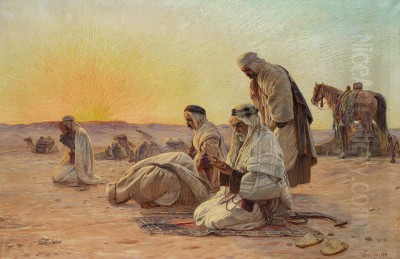
Otto Pilny stands as a notable figure within the later phase of European Orientalism, an artistic movement captivated by the cultures, landscapes, and peoples of North Africa, the Middle East, and Asia. Born in 1866 and passing away in 1936, Pilny, an artist of Czech origin who spent much of his productive life in Switzerland, dedicated his career to capturing the perceived exoticism and daily realities of the East, particularly Egypt. His canvases serve as windows into a world that fascinated Western audiences, filled with vibrant colours, detailed observations, and often romanticized narratives drawn from his own travels and experiences.
Early Life and European Roots
Otto Pilny was born in České Budějovice (then Budweis, part of the Austro-Hungarian Empire, now in the Czech Republic) in 1866. While details of his earliest artistic training remain somewhat scarce in widely available records, it is understood that he received foundational instruction likely within the artistic centres of the Austro-Hungarian Empire, possibly including Prague, before establishing his professional career. Growing up in the latter half of the 19th century, Pilny emerged during a period when academic realism still held considerable sway, even as movements like Impressionism and Post-Impressionism were challenging traditional artistic norms elsewhere in Europe, particularly in France.
The artistic environment of Central Europe at the time would have provided Pilny with a solid grounding in drawing, composition, and oil painting techniques. This academic foundation is evident in the careful rendering and attention to detail that characterize his later Orientalist works. However, like many artists of his generation, Pilny felt the pull of subjects beyond the familiar landscapes and portraiture of Europe. The allure of the "Orient," fueled by colonial expansion, increased travel, and popular literature, offered a rich tapestry of new themes, colours, and light.
The Fascination with the East: Orientalism
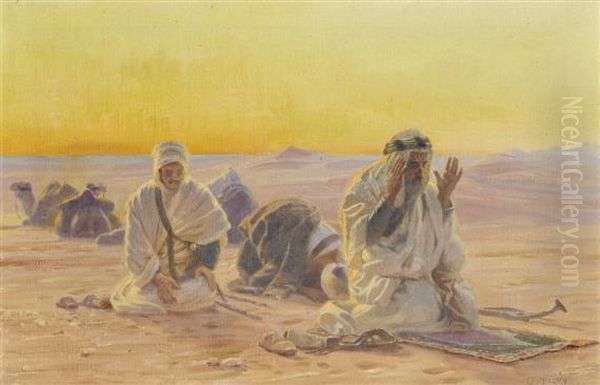
The Orientalist movement, which reached its zenith in the 19th century, was a complex phenomenon. It encompassed a wide range of artistic styles and attitudes, from the meticulous detail of academic painters like Jean-Léon Gérôme to the more romantic and colour-focused visions of Eugène Delacroix. Artists were drawn to the perceived exoticism, sensuality, and historical depth of Eastern cultures. Subjects ranged from bustling marketplaces and serene mosque interiors to dramatic historical reenactments, intimate harem scenes (a subject less prominent in Pilny's known work compared to some contemporaries), and ethnographic studies of local peoples.
Painters like Ludwig Deutsch and Rudolf Ernst, Austrian contemporaries of Pilny who also specialized in Orientalist scenes, became renowned for their highly detailed and polished depictions of guards, scholars, and street life. Others, such as the British artist John Frederick Lewis, spent considerable time living in Cairo, producing intricate watercolours and oils of domestic interiors. David Roberts, earlier in the century, had created influential lithographs of Egyptian and Near Eastern monuments. Pilny entered this established tradition, bringing his own perspective shaped by direct experience.
Journeys to the Nile: Direct Observation
A pivotal moment in Otto Pilny's career was his decision to travel to Egypt. The provided information suggests an initial trip around 1885, followed by a more extended stay, possibly between 1889 and 1892. During this period, he reportedly journeyed along the Nile River, travelling from the bustling metropolis of Cairo southwards to Luxor, the site of ancient Thebes. This immersion in Egyptian life and landscape was crucial. Unlike artists who relied on photographs, studio props, or fleeting visits, Pilny's extended stay allowed for deeper observation.
He would have witnessed firsthand the daily rhythms of Cairo's streets, the grandeur of its Islamic architecture, the vastness of the surrounding desert, and the distinct cultures of its inhabitants, including Bedouin nomads. This direct experience infused his work with a sense of authenticity, even if filtered through a European lens and tailored to the tastes of his audience. His time in Egypt provided him with a wealth of sketches, studies, and memories that would fuel his artistic production for years to come upon his return to Europe, where he settled in Zurich, Switzerland.
Artistic Style: Realism and Atmosphere
Pilny's style is firmly rooted in realism, characterized by careful draughtsmanship and a commitment to representing textures, fabrics, architectural details, and human anatomy accurately. He employed a rich colour palette to convey the intense light and vibrant hues associated with North Africa – the deep blues of the sky, the warm ochres and yellows of the desert and buildings, and the varied colours of traditional clothing and market goods.
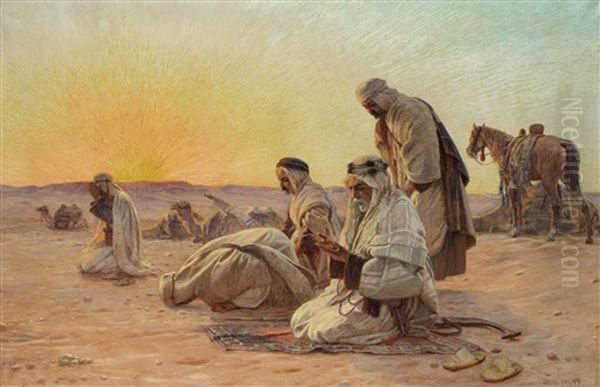
His brushwork is generally controlled and precise, allowing for the detailed rendering that his audience appreciated. He paid close attention to the play of light and shadow, using it to model forms, create depth, and enhance the atmosphere of his scenes, whether depicting the cool interior of a mosque or the bright glare of the desert sun. While adhering to realistic representation, his work often carries a romantic undertone, typical of much Orientalist painting, sometimes emphasizing the picturesque or the dramatic aspects of his chosen subjects. Compared to the highly polished, almost photographic finish of Gérôme or Deutsch, Pilny's work can sometimes exhibit a slightly looser, more painterly quality, though still focused on detailed observation.
Themes in Pilny's Oeuvre: Desert and City
Otto Pilny explored several recurring themes within his Orientalist repertoire, drawn largely from his Egyptian experiences. His works offer glimpses into different facets of life as perceived by a European visitor at the turn of the century.
Desert Life and Bedouin Culture
The desert landscape and the lives of the Bedouin people who inhabited it were frequent subjects for Pilny. He painted scenes of camel caravans traversing sandy dunes, Bedouin encampments at rest, and moments of daily life and ritual in the harsh desert environment. These works often emphasize the vastness and silence of the desert, contrasting it with the colourful figures of the nomads and their animals. Works like Evening Prayers in the Desert capture the spiritual practices integrated into the fabric of desert life, depicting figures in moments of quiet devotion against the backdrop of a dramatic sunset. These paintings catered to the European fascination with the perceived freedom and ancient traditions of nomadic peoples.
Urban Scenes and Architectural Studies
Cairo, the vibrant heart of Egypt, provided Pilny with endless inspiration. He depicted bustling market streets (souks), filled with merchants, shoppers, and animals, capturing the energy and sensory richness of urban life. Architectural studies, particularly of mosques, were another important theme. His painting Mosque of Sultan Hassan, Cairo, mentioned in the source material, exemplifies this interest. Such works allowed Pilny to showcase his skill in rendering complex architectural forms, decorative tilework, and the interplay of light within sacred spaces. These scenes often included figures engaged in prayer or quiet contemplation, adding a human element to the architectural focus.
Figures, Daily Life, and Rituals
Beyond landscapes and cityscapes, Pilny often focused on the people of Egypt. He painted portraits and genre scenes depicting musicians, dancers, artisans, and individuals engaged in everyday activities or religious observance. Morning Prayers, another title mentioned, likely falls into this category, perhaps showing figures performing ablutions or praying within a domestic or mosque setting. These works aimed to provide insight into the customs and cultural practices of the region, satisfying the ethnographic curiosity of his Western audience while often framing these activities within picturesque compositions.
The Controversial Gaze: Slave Market Depictions
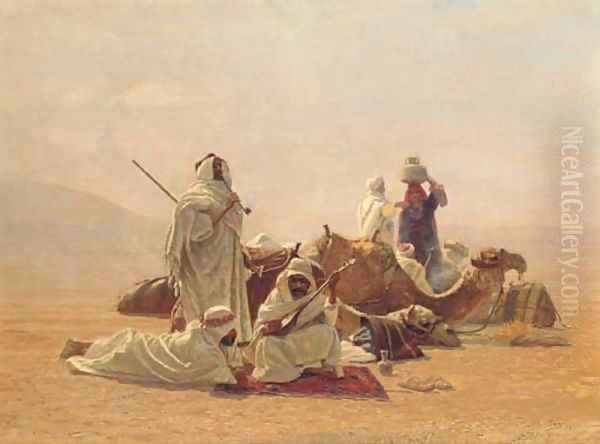
Among Pilny's most notable, and from a modern perspective, most problematic works are his depictions of slave markets. The painting Le Marché aux esclaves (The Slave Market), dated 1910, and potentially Slave Caravan (mentioned as dated 1922, though the source had a typo in the artist's name), fall into this category. These works, while demonstrating his technical skill, engage with a subject that was both sensational and deeply troubling.
Orientalist depictions of slave markets often blended ethnographic observation with voyeurism and racial stereotyping, catering to European preconceptions and fantasies about the East. While Pilny's paintings might have been intended, or interpreted by some, as critiques of the practice (as suggested by one source snippet describing Le Marché aux esclaves as showing the "darkness" of the market), they inevitably participated in the objectification and exoticization of non-European peoples, particularly women. It is crucial to view these works within their historical context while acknowledging the ethical issues inherent in their subject matter and representation. Artists like Jean-Léon Gérôme also famously depicted slave markets, contributing to a genre that reinforced Western notions of Eastern despotism and sensuality.
Patronage, Recognition, and Career in Zurich
Otto Pilny achieved considerable success during his lifetime. His Orientalist paintings found a ready market among European collectors fascinated by his exotic subjects and detailed style. He established his base in Zurich, Switzerland, and from there, continued to produce and exhibit his work. His reputation extended beyond the usual art markets.
A significant indicator of his standing, particularly regarding his connection to Egypt, was the honour bestowed upon him by the Egyptian ruler. In 1906, Khedive Abbas Hilmi II (the last Khedive of Egypt and Sudan) awarded Pilny the Order of the Medjidie, 4th class. This honour, mentioned in the source material, suggests that Pilny may have served, formally or informally, as a court painter or was highly regarded by the Egyptian elite. This connection lends credence to the idea that his depictions, while filtered through a European sensibility, were based on significant access and observation within Egypt. This patronage undoubtedly enhanced his prestige back in Europe.
Pilny in Context: Contemporaries and Legacy
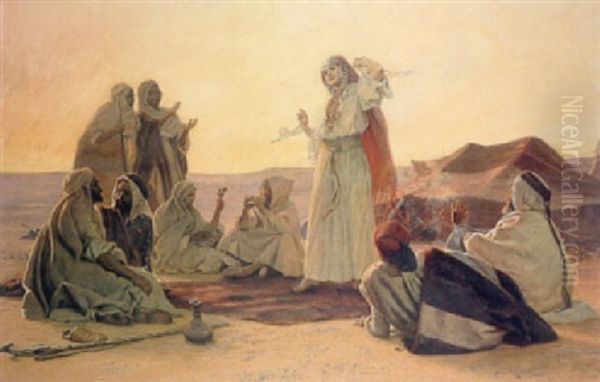
Otto Pilny operated within a thriving European art market where Orientalist themes remained popular well into the early 20th century, even as modernist movements were gaining momentum. He was a contemporary of other successful Orientalists like the aforementioned Ludwig Deutsch and Rudolf Ernst, as well as artists like Frederick Arthur Bridgman, an American painter known for his North African scenes, and the Italian painter Alberto Pasini. While perhaps not reaching the same level of fame as Gérôme or the innovative impact of Delacroix, Pilny carved out a successful niche for himself.
His work can be seen as representative of the later stage of academic Orientalism, characterized by high technical skill, a focus on ethnographic detail (or perceived detail), and subjects chosen for their picturesque or dramatic appeal. He provided European audiences with vivid, accessible images of a world perceived as distant and exotic.
Today, Otto Pilny's work, like all Orientalist art, is viewed through a more critical lens. Art historians and cultural critics analyze the power dynamics inherent in the European gaze upon the East, the tendency towards stereotyping, and the ways in which these images often reinforced colonial attitudes. However, his paintings remain valuable historical documents, reflecting the tastes and preoccupations of his era and showcasing his considerable skill as a painter dedicated to capturing the light, colour, and life of Egypt as he experienced it. His dedication to his chosen subject matter and the quality of his execution ensure his place as a significant practitioner within the Orientalist tradition. His works continue to appear at auction, appreciated for their technical merit and as evocative examples of a specific moment in European art history.